Hericium and lions mane mushrooms are a beautiful, edible mushrooms that can resemble bunches of coral or furry pom pom balls. They're relatively common, easy to identify, harvest and cook. I'll describe where and when to find them, how to tell which one you have, and how to cook them.

Above: H. coralloides, the coral tooth fungus, is one species of a number of edible North American Hericium.
What Are Lions Mane Mushrooms?
Lions mane mushrooms are a saprobic, parasitic decomposer of hardwood trees, and a widely popular edible, cultivated, and "medicinal" mushroom. They're one of a number of species of Hericium mushrooms that come in a number of forms, all of which are snow-white in color.
Their tell-tale characteristic is being one of the few varieties of mushrooms that have spines or teeth. The "toothed" attribute on all species sets them apart from thousands of other mushrooms that don't have them, making them easy to identify.
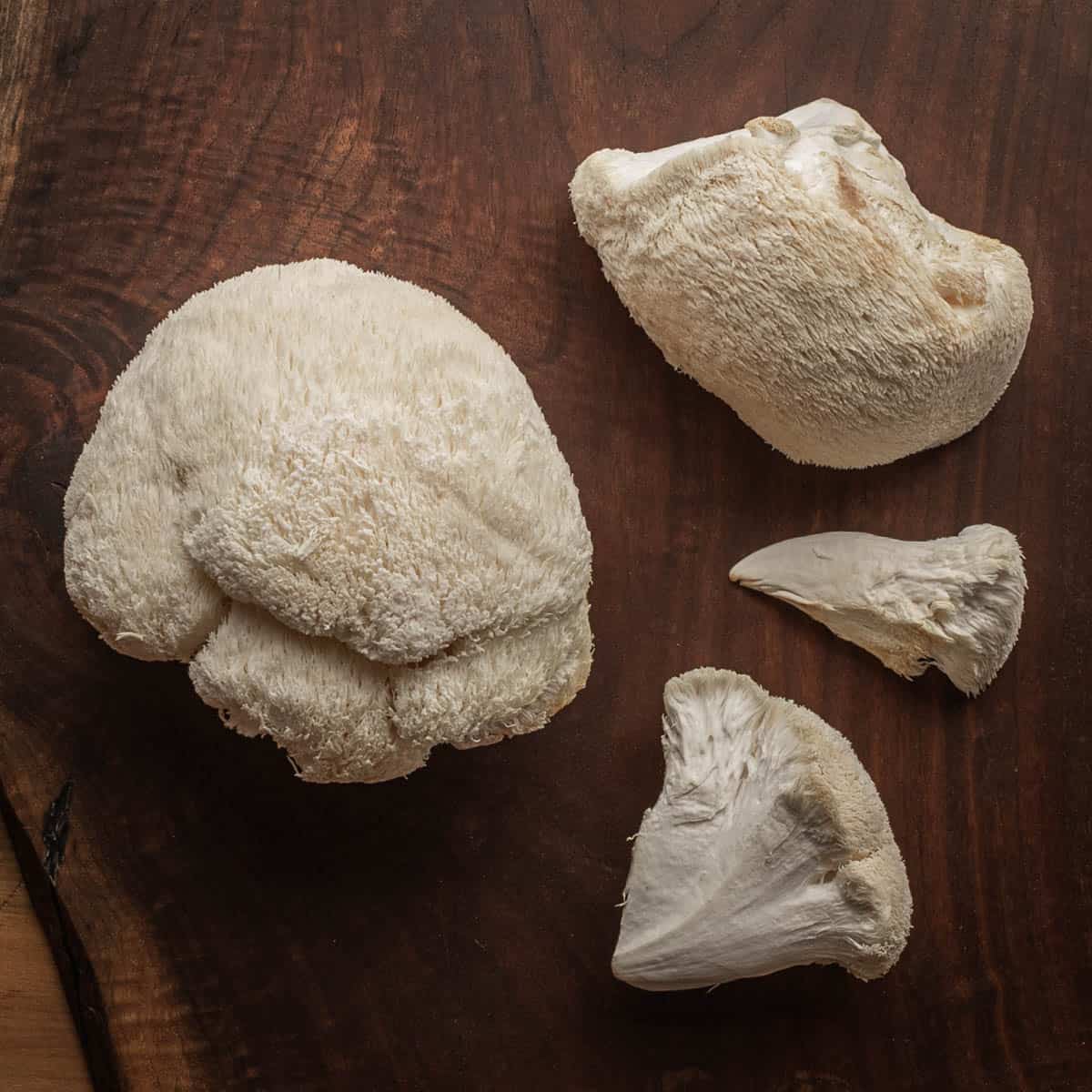
Where to Find Lions Mane Mushrooms
These start to appear sporadically in the late Fall in the Midwest on hardwood trees like oak maple when the leaves start to drop and there's been a few cool nights. Each mushroom eating a decomposing tree seems to have their own internal clock when it decides to fruit, similar to chicken of the woods.
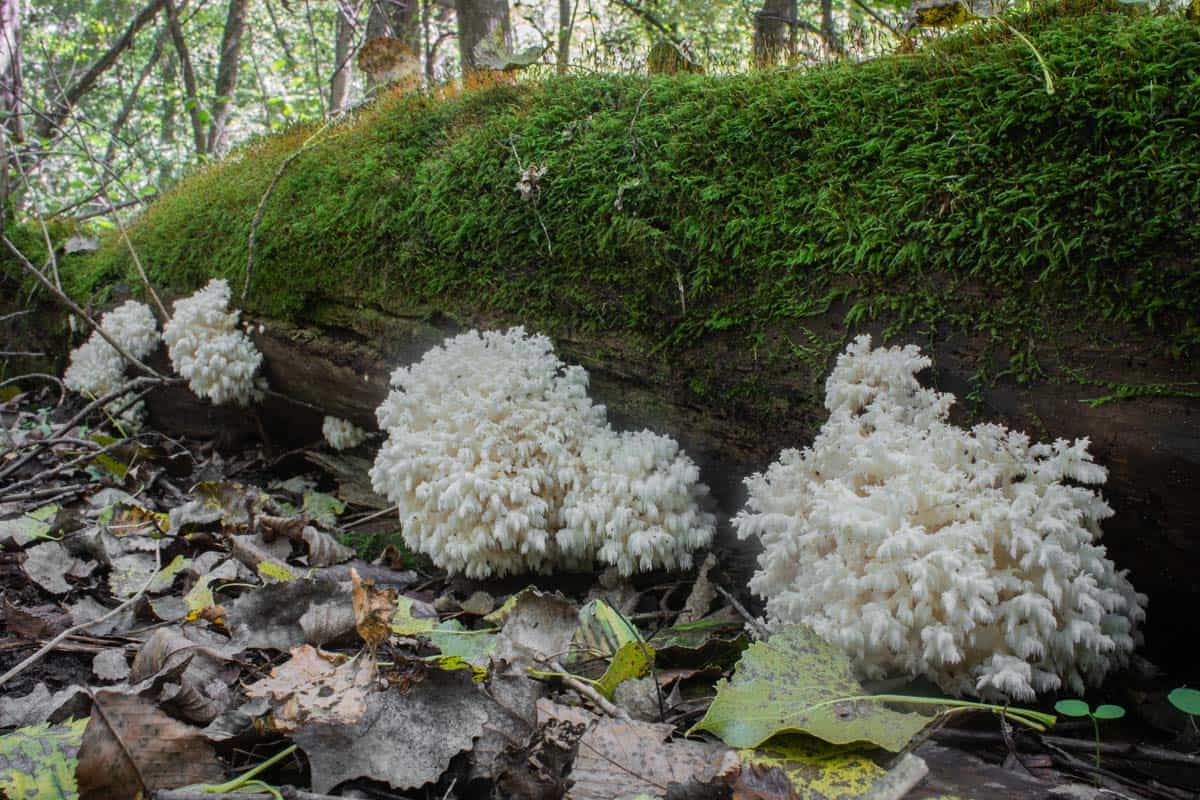
Ideally you'll be in a place that has decomposing wood, not just old fallen trees. Look for fallen trees that are decomposing and covered with moss. This could be in a backyard, on the side of a trail, or deep in the woods. In the Midwest, the preferred host tree species is usually rotting oak logs and old, fallen maple trees for me.
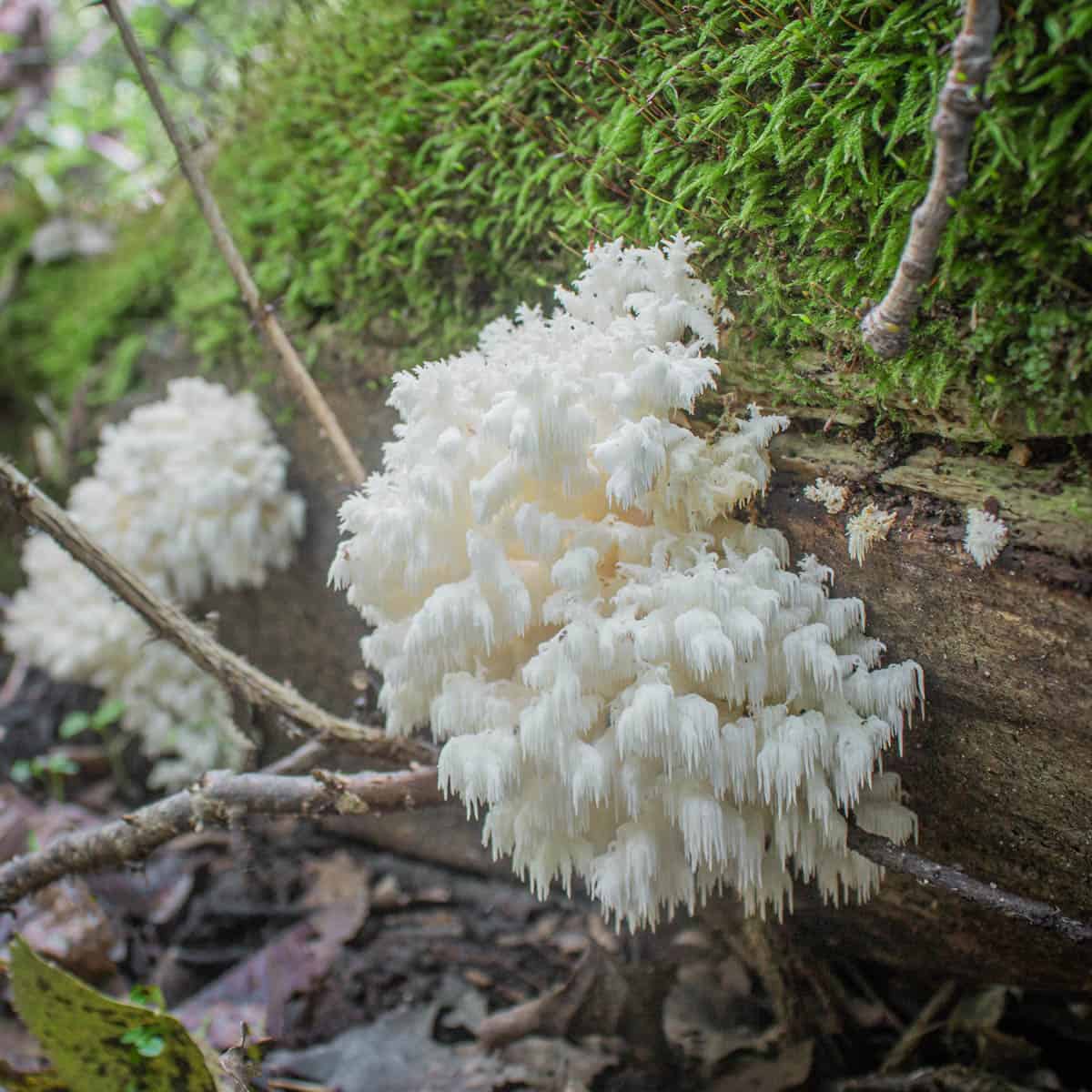
You can hunt for these casually by inspecting old logs covered in moss you come across while looking for other fall mushrooms. The mushrooms can be tricky to spot, and may grow hidden under the bark of fallen trees with only a small portion visible to the naked eye.
Three Hericium Species
I harvest three different species of Hericium that are easy to tell apart. I explain the differences below. Besides the mushrooms below, there's also Hericium abietis from the Pacific Northwest, which grows on spruce, fir and hemlock, and may have a pinkish color when young.
Lions Mane (Hericium erinaceous)
A commonly cultivated species, H. erinaceous is the typical, white pom-pom shaped mushroom sold in high end grocery stores. Asian markets often sell them dried, which I don't really care for unless you're making stock and discarding them.

In the wild these are easy to identify as they're the only species that forms a dense, single clump of spines instead of the branching structure of H. corralloides and others. They also have the longest spines of all species.
Very young Hericium mushrooms of all species can be look similar when young though, appearing as a single clump with short spines.
Cultivated hericium (I have only seen hericium erinaceaus cultivated and sold wholesale so far) will taste fantastic grown on a log in your back 40.

The ones I've tasted grown from mushroom socks, grow bags and cultivating kits don't have a lot of flavor. Like cultivated hen of the woods, they taste like their substrate, which is means they taste like white button mushrooms with a different shape. They're a decent mushroom, just not as good as their wild cousins.
Coral Tooth Mushroom (Hericium coralloides)
The coral tooth Hericium are the most common that I see in the Midwest. With their meaty texture and asymmetrical coral shape, they're the most prized mushrooms of the genus.

It's notorious for growing hidden underneath the bark of trees, and can turn into long, thick strands of coral a couple feet long. Note how the fingers branch unevenly like coral and that the spines are shorter than H. erinaceous.
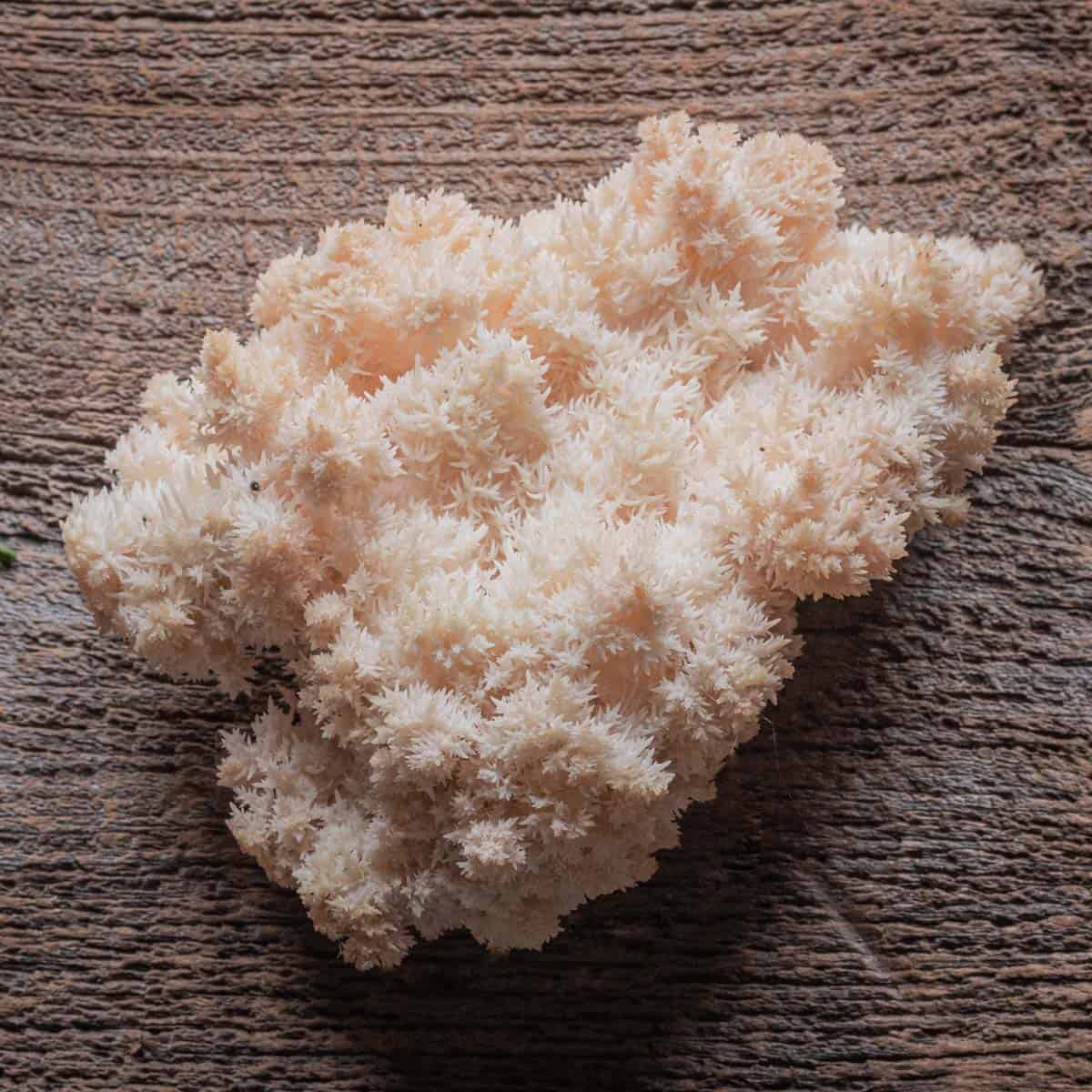
Bearded Tooth Mushroom or Bears Head (Hericium americanum)
Another great edible mushroom, you can tell these apart from the other two as they're composed of loosely clustered tufts of drooping teeth. I see them growing occasionally on dead oak trees. Like H. corralloides, their spines are shorter than H. erinaceous at maturity.
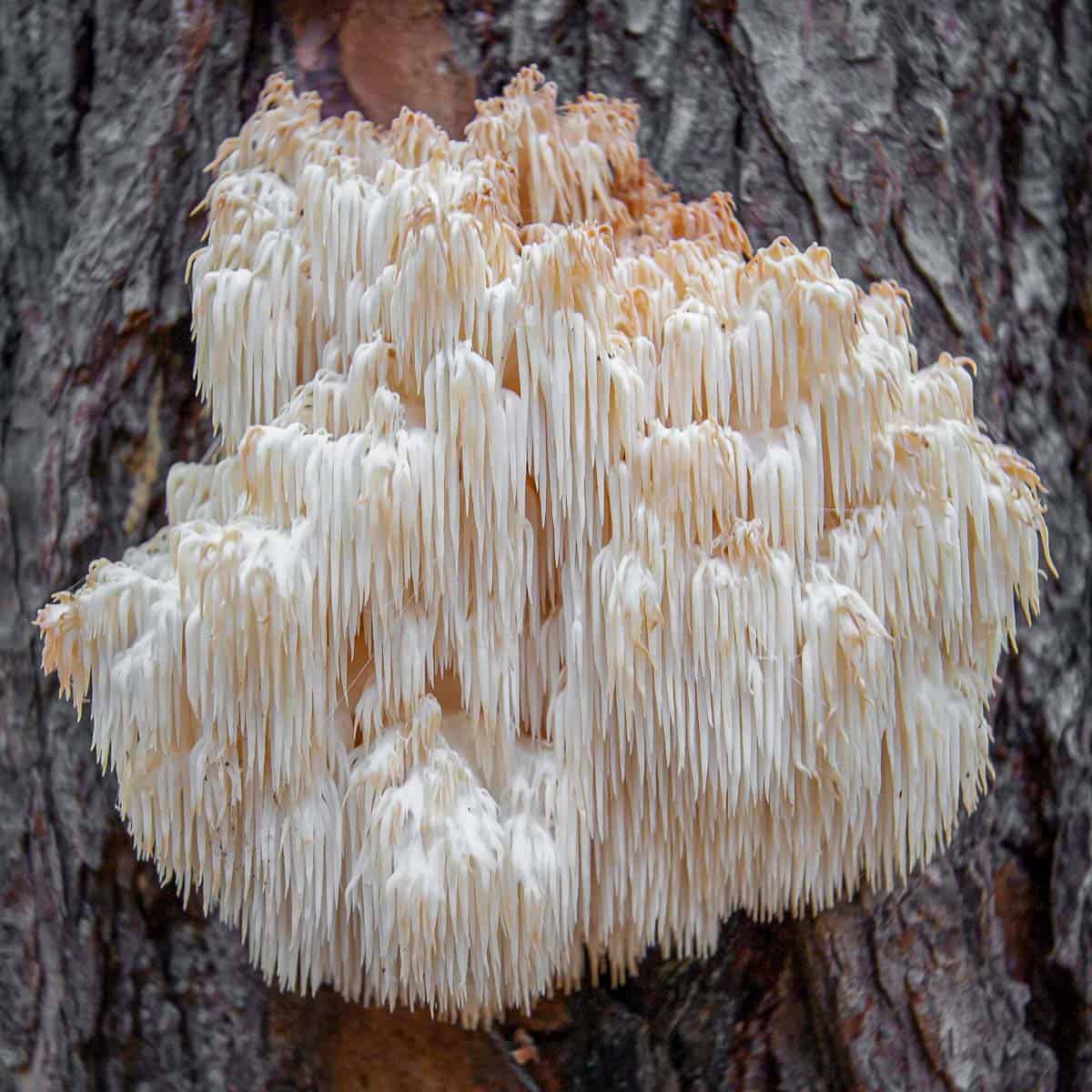
How to Clean Lions Mane Mushrooms
Choose hericiums that are bouncy and firm, snow-white, and fresh looking. Some yellowing will happen with age and is harmless. Rusty brown or wet spots can mean they're too old to eat. If you're lucky, your mushroom will be relatively clean and you can just throw them into the pan with butter.

If it rained recently your mushroom may be dirty. All the teeth and crevices can hold debris. To clean Hericium and lions mane mushrooms, I swish the mushrooms around in a sink of cold water quickly, then remove and put them on a clean towel. If the mushrooms have dried out at all, it can be impossible to completely remove the dirt and they should be composted
Store washed, cleaned lions mane mushrooms in a Zip Loc bag with a dry paper towel and keep in the fridge. Store dry lions mane the same way, with a moist paper towel. Very fresh mushrooms will last a week. Mushrooms from a store will usually last 3-4 days.

How to Cook Lions Mane Mushrooms
Lions mane mushrooms taste slightly mushroomy and nutty, with a subtle hint of shellfish some people might not notice. Their flavor and texture have been compared to crab meat. Here's a few tips on cooking with them.
- You can pull the mushrooms into pieces and make Hericium crab cakes, or mock fish stew.
- Use them in any recipe you'd use small pieces of clam or fish like a chowder.
- Just like crab, they're great steamed with drawn butter.
- Wild mushrooms are sweet, mild, and delicious. Cultivated mushrooms are mild in flavor and may need additional seasoning.



Above: pull the mushrooms into pieces and saute, fry or put in soup. Large, clean mushrooms can be cooked in thick slices like steaks.

How to Preserve Lions Mane Mushrooms
There's a number of ways to preserve these mushrooms: dehydrating, pickling, freezing, and freeze drying. For pickling, my favorite method is mushroom conserve-see a link for that below.
To freeze the mushrooms, they should be cooked before being frozen. If they're frozen raw they'll turn yellow and develop a terrible aroma, making them inedible-see below.
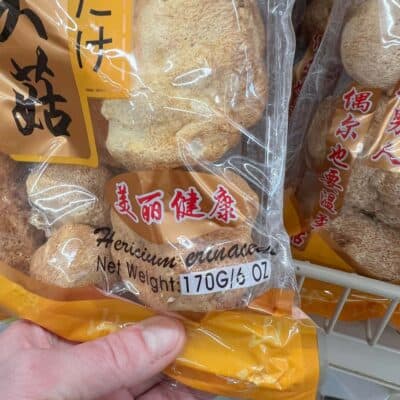
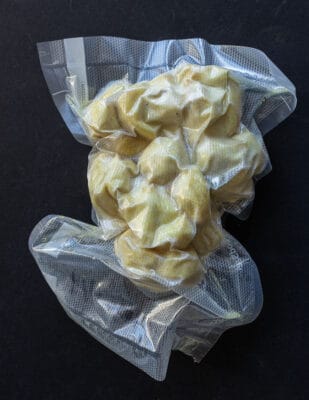
Above: dried mushrooms at the store, and frozen lions mane that have discolored.
Drying the mushrooms works, but they don't get very tender even after long cooking, so this is best used for soups and stocks. You can buy dried lions mane at Asian grocers 6 oz cost around $6.99.
Dry your own mushrooms by breaking them into pieces or using small 2-3 oz clusters dry in the dehydrator at 125 F for 24 hours for small pieces, and up to 3 days using larger clusters, or until bone dry.
Lions Mane Mushroom Recipes
You can use these mushrooms in place of your favorite mushrooms in cooking. Large varieties are make a great mushroom meat substitute in vegan and vegetarian mushroom recipes. Here's the best recipes I've made specifically for lions mane, or where they can be substituted.
Lions Mane Crabcakes
One of the most well known recipes. These can be made from any type of Hericium.

Wild Mushroom Chowder
A rich wild mushroom chowder with bacon and leeks is a great way to use the white color of the mushrooms.

Steamed Hericium with Drawn Butter and Fried Herbs
A simple recipe for enjoying the mushrooms like crab. Only wild mushrooms should be used this way.

A few other recipes I recommend are:
- Wild Mushroom Conserve (Pickled Mushrooms)
- Wild Mushrooms With Garlic and Parsley
- Wild Mushroom Gratin With Leeks
FAQ
Your local coop or high end grocery store may carry them. You can also contact local mushroom growers who sell to the public, or order them online through companies like Bristol Mushrooms.
No, but they will make you feel happy after you eat them.
Yes, but the mushrooms must be cooked before freezing. Gently cook in butter or olive oil, portion into a zip loc bags and freeze the portion bags in a vacuum seal bag to pull from as needed.
Pull the mushrooms apart into bite-sized pieces. Sweat them in a little butter or oil and season with salt for the best flavor, or add them directly to the soup.
The mushrooms should be pure white inside and out with no discoloration. If they're dry, the teeth can turn a light rusty brown, but as long as the mushrooms are white inside they're fine to eat.
Although edible at any stage where they're white and fresh, the best time to Harvest lions mane is when the teeth or toothed branches are fully formed and articulated.

Jim
Thanks for putting this info on the interweb. Thanks for the advice.
I've been lucky enough to have cultivated H. Americanum on totem logs outdoors in Carolina. A large amount and also Lions Mane, Shiitake, Oyster, and Chestnut also.
We look forward to preserving and eating them. How did you get to know these fungus?
Please come to visit and we'll eat well!
Keith Martin
Hello. Love your advise. I do go hunting for the Tooth's and am moving from the cave country region of Kentucky (I lived next to Mammoth Cave National Park for 16 years) to western Kentucky. Just back from 6 weeks of camping and learned a tiny fraction of Land Between The Lakes area and found it is going to be a wonderful place to forage. I called Lions Mane a Bear Tooth...will recheck my Audubon guide. And 2 out 3 we're on live and healthy white shaggy oaks. One on a dead log. Been shrooming 7 years and had a mentor in the park. Look forward to following you, and hopefully you have a restaurant.
Alan Bergo
Hey Thanks Keith. Fortunately for me, and unfortunately for diners, my last restaurant closed in 2018, and I couldn't be happier. Instead of working for a corporation or another master, I now work completely for myself and get to share 10x the information on here with readers that I was previously. That being said, if you're in the Midwest I do dinners and events on occasion and have a few coming up in the winter.
Keith Martin
I humbly correct myself that the ones I found are the Bearded Tooth also known as a Hedgehog. I hope to meet you and we can see about one of those dinners. Thanks again, I will now attempt crab cakes.
Keith cross
Any advice on the best way to store uncooked Hericum Corrolloides? My son found one today in our yard.
TomMeg
Just wanted to share my recent discovery that a Water Pik does a pretty good job of getting grit out of Hericium sp. (and onto the bathroom counter and mirror).
Ella
Any suggestions on baking time prior to preserving/freezing?
Alan Bergo
I would not reccomend baking them. Dry heat of the oven will dry them out too much. I would sweat in butter, poach or blanch on top of the stove, then freeze. Cook time is relative to the size of the mushroom, a couple minutes for clusters the size of a nickel.
Rodger K. HAmilton
I have had great success dehydrating and powdering hericeum, storing in glass jars and using in sauces and soups. I also smoked them over cherry wood, which makes them tasty and preserves them dry and crumbly, but obscures the lovely natural flavor.
Rodger K. HAmilton
Here in Vermont Hericium varieties are found in September and October. They can be reliably sought after if you know a woods with old beech trees, specifically big dead beech logs.
If I have a goodly harvest, I dehydrate them and then powder them in my coffee grinder. Store in a glass jar, and use in sauces. Another way to enjoy them is to dip in tempura batter and deep fry. They also make a respectable faux crab cake - or mix them right into the crab cake mixture!
Happy hunting, and bon apetit!
Rodger
Michele
I have a couple of dead poplar or alder trees deposited in my back "40". There are 3 north pointing ends that are growing hericium. If I harvest will they come back next year? I live in north central Oregon. No rain from mid July to mid Sept but then it rains or snows until May/June. Can I leave the logs where they are? Should I harvest before the first freeze.
Thank you for your wonderful website
Michele
Alan Bergo
Hi Michele, by all means harvest as many of the Hericium as you like, the sooner the better. You're not harming the mushroom by taking it, it's more like taking an apple from a tree to use an analogy. Thank you, too.
Tyler
Yes. They are a perennial mycelium. Roth.tb@gmail.com . Im in Hood River
david daniel
How about a Hericium Ceviche recipe? I think it might be a good fit.
Domi
I have found several kilos of this mushroom on a large dead log in a forest near Budapest, on one of the Pilis hills. They had different sizes and two exemplars had a diameter around 40 cm. It was really a great and lucky catch. It was on the north-east side of the hill, no sun and very humid, calcareous soil (i know that should not make any difference since they live in dead trees). These days has been raining quite a lot and was relatively warm (over 20 degrees Celsius).
Danae Bruning
Sorry about the teaser, Mr. Farmer sent this morning. I guess I need to read your blog more. They sure were pretty. Still are, as they are still attached to the tree.
Alan Bergo
Danae, these are rare treats indeed. I haven't seen a hericium yet this year so good for you. Once upon a time these were a prize for me to show off to specialty chef's tables since they typically don't get so huge like hens. Maybe someday again.... You'll remember next time, I bet.
Tyler
I get them on a yearly basis in one spot up to well 10 -15 pounds. If your interested j can get you some corralloides type depends on how much rain we have. Hands down my favorite mushroom for eating I live in the Midwest northwest Iowa.
Alan Bergo
They're great mushrooms.